Physical Address
304 North Cardinal St.
Dorchester Center, MA 02124
The disappearance of the class Zygomycetes from current taxonomy has made the term zygomycosis obsolete. The term zygomycosis encompassed both mucormycosis and entomophthoramycosis. These two infections are so different that no new name has been proposed to include both infections. Most of this chapter discusses mucormycosis, a group of filamentous fungi in the subphylum Mucoromycotina that belong to the order Mucorales. Mucorales can cause life-threatening infections in humans, especially in immunocompromised hosts. The first documented report of human mucormycosis is credited to Paltauf, who in 1885 reported a disseminated infection in a patient with rhinocerebral involvement caused by angioinvasive, ribbon-like hyphae that he termed Mycosis mucorina . Subsequent descriptions of the infection in the following decades relied on tissue morphology and, as often is the case today, were infrequently confirmed by culture. Hence the findings of coenocytic (aseptate or pauciseptate) fungal hyphae in tissue invading blood vessels was assumed to be due to Mucor spp. and have become synonymous with the clinical term mucormycosis or, simply, Mucor infection. This terminology is further justified by the fact that all but the rare Mortierella spp. are within the order Mucorales. However, the number of species causing human mucormycosis has expanded considerably in the past 2 decades with improvements in culture-based morphologic identification and the application of more precise molecular diagnostics and sequencing for fungal identification ( Table 258.1 ). In fact, members of the genus Rhizopus, not Mucor, are reported as the most predominant cause of human infections, although in Europe Mucor and Lichtheimia account for approximately one-quarter of reported cases.
| Mucormycosis |
| Rhizopus rhizopodoformis Rhizopus arrhizus (Rhizopus oryzae) Rhizopus microsporus Rhizomucor pusillus Rhizopus stolonifer Cunninghamella bertholletiae Apophysomyces elegans Saksenaea vasiformis Lichtheimia (Absidia) corymbifera Mucor circinelloides Mucor velutinosus Syncephalastrum racemosum Actinomucor elegans Cokeromyces recurvatus Mortierella wolfii |
| Entomophthoramycosis |
| Conidiobolus coronatus Conidiobolus incongruus Basidiobolus ranarum |
Agents of mucormycosis are ubiquitous fungi in the environment that are commonly found in decaying organic substrates, including bread, fruits, vegetable matter, soil, compost piles, and animal excreta. These fungi characteristically produce large, ribbon-like hyphae that are irregular in diameter with only occasional septae, hence the characterization of these organisms as aseptate fungi. Identification can be confirmed by observing the characteristic, saclike fruiting structures (sporangia), which produce internally spherical yellow or brown spores (sporangiospores) ( Fig. 258.1 ). Spores ranging from 3 to 11 µm in diameter are easily aerosolized and dispersed and cause infections in humans when inhaled or introduced through a cutaneous or percutaneous route.
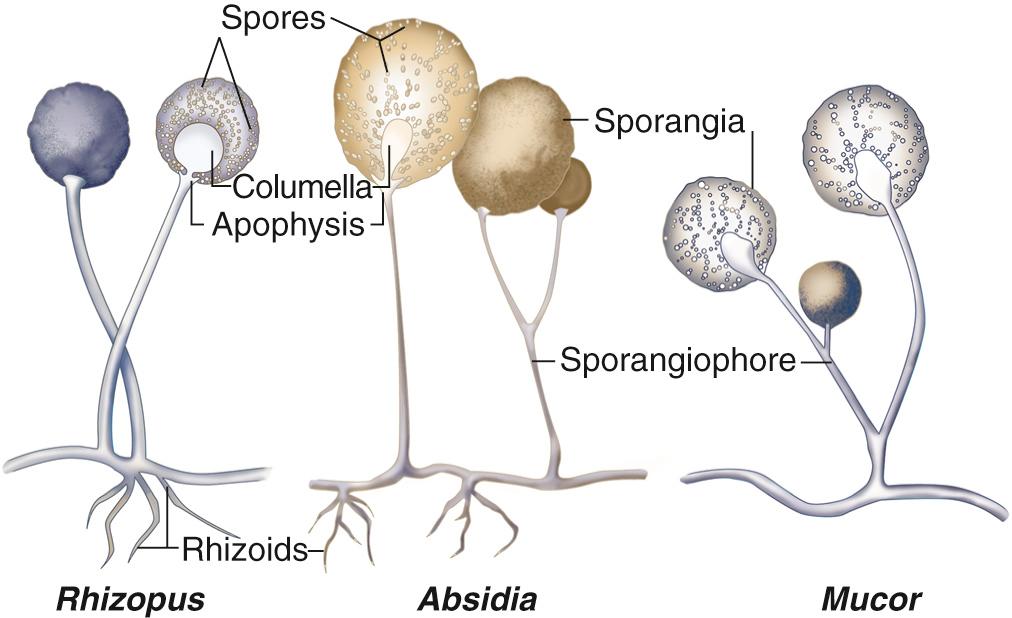
Although several species of the order Mucorales have been reported to predominate as causes of human mucormycosis, culture recovery of these fungi from infected tissue is suboptimal and may skew the current understanding of the etiologic spectrum of mucormycosis. The widening application of molecular diagnostic techniques (i.e., polymerase chain reaction [PCR]) in culture-negative cases may expand the current understanding of the prevalence and etiology of this infection. In a global review of more than 900 reported cases of mucormycosis, Rhizopus spp. (47%) were the most frequently reported causes of culture-confirmed mucormycosis, followed by Mucor spp. (18%), Cunninghamella bertholletiae (7%), Apophysomyces elegans (5%), Lichtheimia (Absidia) spp. (5%), Saksenaea spp. (5%), and Rhizomucor pusillus (4%), with a variety of other uncommon species representing the remaining 8% of culture-confirmed cases.
Seasonal variations may affect the incidence of mucormycosis, with most infections occurring during periods of higher temperatures and decreased precipitation. Likewise, major weather events have also been associated with infections with less frequently isolated species, such as Syncephalastrum racemosum from respiratory samples after Hurricane Katrina, Apophysomyces trapeziformis soft tissue infections in patients with traumatic injuries associated with the Joplin, Missouri tornado, or posttsunami wound infections due to Apophysomyces elegans. Combat wound infections are also influenced by environmental factors, as in Afghanistan, where wounds sustained in the southern regions, with lower elevation, warmer temperatures, and greater isothermality, had greater mold contamination.
The first published genomic sequence of an agent of mucormycosis was Rhizopus arrhizus strain 99-880 (subsequently reclassified as Rhizopus delemar ), which was isolated from a diabetic patient with fatal cerebral mucormycosis. Sequencing revealed the presence of abundant transposable elements accounting for 20% of the genome and evidence of a whole-genome duplication event during the evolution of the fungus. The whole-genome duplication event resulted in duplication of nearly all subunits of the protein complexes involved in respiratory electron transport chains and ubiquitin-proteasome systems, as well as multiple gene families related to cell growth and signal transduction and known fungal virulence factors, including secreted aspartic and subtilase protein families. Sequencing also revealed duplication of the ergosterol biosynthetic pathway (e.g., lanosterol 14α-demethylase), the major target of azoles including voriconazole, isavuconazole, and posaconazole. These genetic features may explain why Mucorales have a uniquely aggressive capacity for rapid growth in patients, even in the face of exposure to antifungal agents and the host immune response. More recent sequencing studies of representative isolates from Mucorales and noninvasive Entomophthorales have identified differences in gene copy numbers that encode spore coat (Cot[H]) proteins, which facilitate invasion of blood vessel endothelial cells. The most commonly isolated Mucorales ( Rhizopus, Mucor, and Lichtheimia ) contain three to seven copies of the cotH gene , whereas those that occasionally cause disease in humans ( Apophysomyces, Cunninghamella, Saksenaea, and Syncephalastrum ) contain only one to two copies. Notably, the cotH gene was lacking in Entomophthorales, which are taxonomically similar to Mucorales but do not cause blood vessel invasion.
The primary mode of acquisition of mucormycosis is inhalation of spores from environmental sources. Trauma, penetrating wounds, burns, and direct injection of sporangiospores can cause infection through a cutaneous or percutaneous route. Gastrointestinal (GI) mucormycosis, although less common, has been reported in both immunocompetent and immunocompromised patients with repeated ingestion of spores during periods of severe malnutrition, ingestion of nonnutritional substances (pica), ingestion of contaminated pharmaceutical products, prepackaged foods, fermented porridges and alcoholic drinks prepared from corn, or eating with contaminated chopsticks. More recently, an outbreak of food poisoning was linked to intake of Greek yogurt contaminated with Mucor circinelloides. It is unclear whether the fungus itself, which could survive transit through the GI tract and retain virulence, or a secondary metabolite or toxin was the cause of clinical symptoms experienced by the consumers.
Agents of mucormycosis are unique among filamentous fungi in their ability to infect a broader, more heterogeneous population of human hosts compared with other opportunistic molds. The epidemiology of mucormycosis is similar in adult and pediatric patients. Although most cases of mucormycosis are community acquired, nosocomial acquisition or pseudooutbreaks have been linked to contaminated bandages and bandage tape, needles, and tongue depressors used to construct splints for intravenous (IV) and arterial cannulation sites in preterm infants. An outbreak of invasive mucormycosis in a pediatric hospital was linked to contaminated bed linens resulting from improper storage, packaging, and transport from an offsite laundry service.
The populations most commonly at risk for mucormycosis include patients with poorly controlled diabetes mellitus, prolonged neutropenia, high-dose corticosteroid treatment, or immunosuppressive therapy associated with transplantation, and/or elevated levels of free iron, which enhances fungal growth. The importance of iron overload in the pathogenesis of mucormycosis was first noted in patients with end-stage renal disease in the preerythropoietin era, where regular transfusions were required for persistent anemia, resulting in iron overload. Treatment of these patients with deferoxamine to lower their iron levels was linked to the development of disseminated, rapidly fatal mucormycosis. It was subsequently discovered that although deferoxamine is an iron chelator for the human host, it also acts as a siderophore in Mucorales, directly delivering iron to the fungus. Less commonly, mucormycosis is a cause of infection in the setting of renal failure, diarrhea, and malnutrition in low-birth-weight infants and rarely in human immunodeficiency patients.
Patients who develop mucormycosis in the absence of underlying disease or immunosuppression at the time of infection frequently have histories of penetrating trauma, burns, surgery, or illicit IV drug use before the infection. For example, a case series of mucormycosis at a nononcology, tertiary care center found that traumatic wounds or surgical sites were the most common infection sites (31%), followed by rhinocerebral (25%) and disseminated (12.5%) infections. Severe soft tissue infections from blast injuries in combat have also caused mucormycosis.
Mucormycosis is infrequently identified as a complication associated with primary immunodeficiency. This complication has occurred in a case of severe congenital neutropenia associated with HAX-1 (HCLS1 [hematopoietic cell-specific Lyn substrate 1]–associated protein X-1) deficiency, or with a newly identified genetic abnormality, such as in a patient with a STAT-1 (signal transducer and activator of transcription-1) gain-of-function mutation who presented with disseminated Apophysomyces trapeziformis infection.
Mucormycosis is not a reportable disease. The incidence of mucormycosis is probably underestimated in many epidemiologic series given the inherent challenges associated with antemortem diagnosis and the declining rate of autopsies in high-risk populations. A recent estimate of the disease burden of mucormycosis in US hospitals from 2005–15 reported a prevalence of 0.12 to 0.16 cases per 10,000 discharges, depending on the International Classification of Diseases–9 code definitions used to define the disease. Cases of mucormycosis were associated with an average hospital length of stay of 17 days, with 23% dead at discharge and more than one-third of patients requiring readmission to the hospital. The average cost per hospital stay was $112,419 (2014 US dollars). Surveys from Europe have reported incidence rates of mucormycosis ranging from 0.43 to 1.2 cases per million people. In autopsy series of high-risk hematology populations, mucormycosis has accounted for 8% to 13% of all reported invasive fungal infections.
Mucormycosis is an important cause of fungal infections in patients with hematologic malignancy, recipients of allogeneic hematopoietic stem cell transplant (HSCT), and, less commonly, patients undergoing solid-organ transplantation (SOT) ( Fig. 258.2 ). Data from the Centers for Disease Control and Prevention (CDC) Transplant-Associated Infection Surveillance Network (TRANSNET) acquired from prospective surveys of 25 US transplantation centers from 2001–06 reported 1-year cumulative incidence rates for mucormycosis of 0.29% in allo-HSCT and 0.07% in SOT, accounting for 8% and 2%, respectively, of fungal infections diagnosed in these populations. Of concern, some mucormycosis cases have presented as breakthrough infection on antifungal prophylaxis or treatment effective against Aspergillus but not Mucorales (i.e., voriconazole, echinocandins) or because of potentially insufficient absorption of posaconazole. Collectively, these data suggest that mucormycosis should be considered in any high-risk hematologic malignancy patient whenever fungal sinusitis develops on Aspergillus- active antifungal prophylaxis, especially in patients with prolonged immunosuppression and underlying hyperglycemia associated with prolonged corticosteroid use.
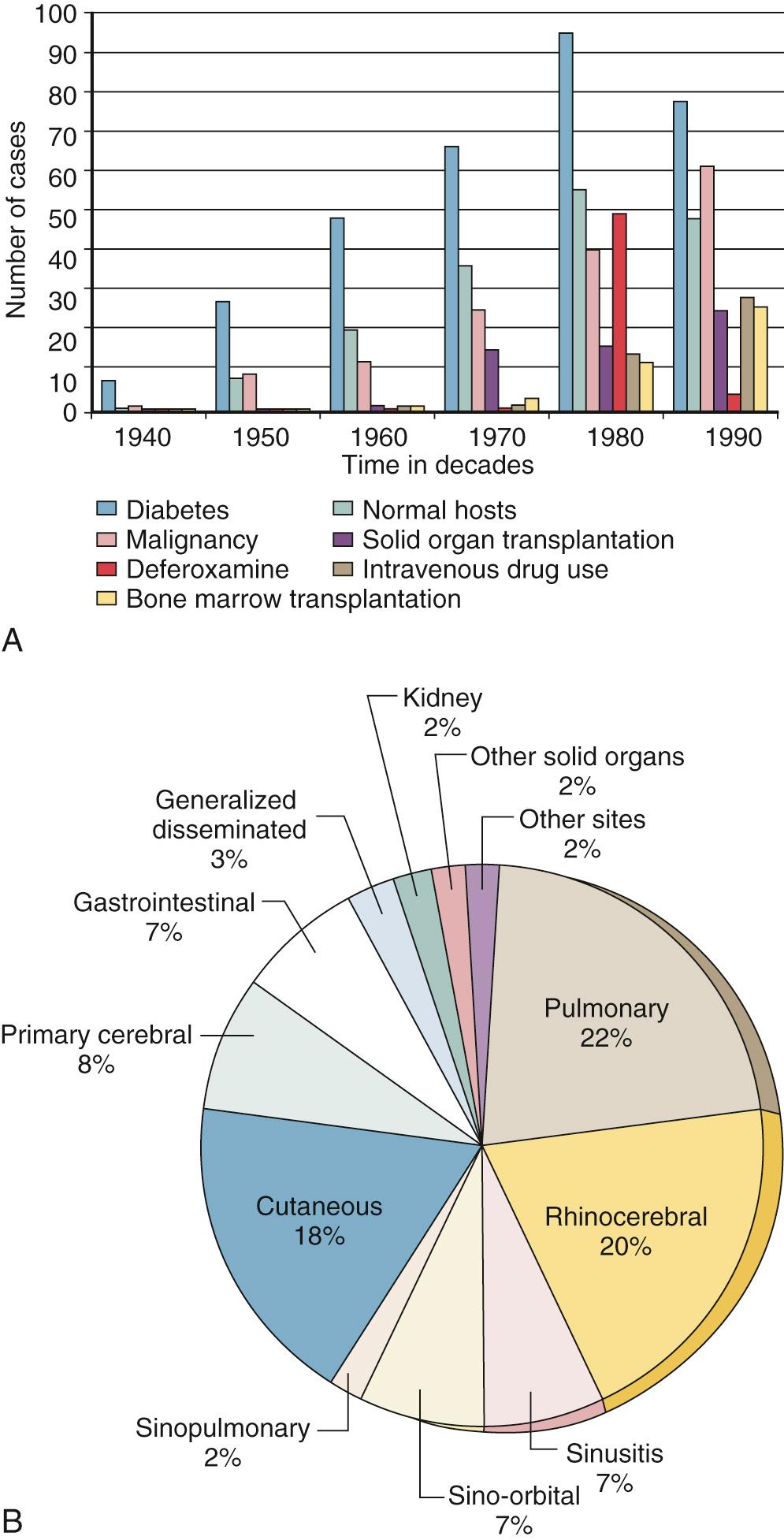
Most Mucorales sporangiospores are sufficiently small to evade host upper airway defenses and reach the distal alveolar spaces after inhalation. Larger spores (>10 µm) may lodge in the nasal turbinates, predisposing patients to sinusitis. Inhalation of a high spore inoculum, which can occur with excavation, construction, or work in contaminated air ducts, can lead to a slowly progressing pulmonary mucormycosis even in immunocompetent hosts. In the case of primary cutaneous mucormycosis, subcutaneous inoculation of spores is the most common event leading to infection in immunocompetent hosts. Cutaneous mucormycosis in immunocompetent hosts usually follows massive soft tissue injury but has been described with even minor trauma, including insect bites and tattoos.
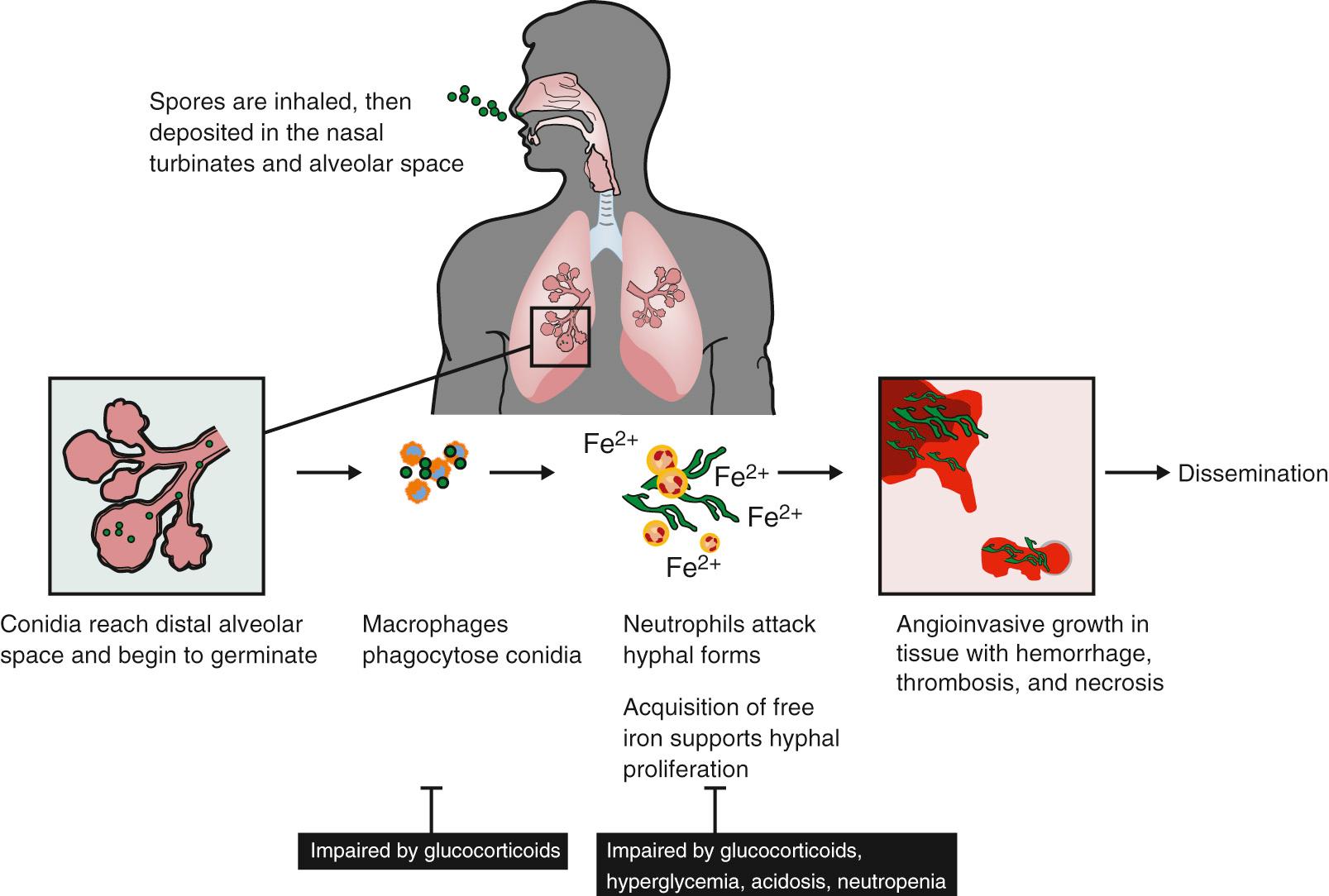
Relatively little is known about initial steps of how Mucorales sporangiospores attach to the respiratory or GI epithelium. Rhizopus sporangiospores can adhere to extracellular matrix proteins, such as laminin and type IV collagen, which may be exposed after epithelial damage caused by cytotoxic chemotherapy, infection, diabetes, or trauma. Toxins elicited by Mucorales during germination may contribute to epithelial cell damage. A recent outbreak of food poisoning linked to intake of Greek yogurt contaminated with M. circinelloides identified secondary metabolites produced by the contaminating strain that were toxic to the GI mucosa.
Mucorales appear to possess a unique mechanism for adhering to and invading endothelial cells by specific recognition of host receptor–glucose regulator protein 78 (GRP78). Expression of GRP78 on the endothelial cell surface increases as a stress response after exposure to elevated concentrations of β-hydroxy butyrate (BHB), glucose, and iron, similar to those found in patients with diabetic ketoacidosis. Mucorales germlings, but not sporangiospores, bind to GRP78, initiating endothelial cell–mediated fungal endocytosis, resulting in host cellular death. Suppression of GRP78 expression or blocking its function by antibodies suppresses fungal invasion of host endothelial cells by Mucorales, but not Aspergillus fumigatus or Candida albicans . Endothelial cell uptake is also enhanced through activation of host platelet-derived growth factor pathways (PDGF) because treatment with small-molecule inhibitors of PDGF reduces endothelial cell damage caused by Rhizopus .
Proteins from the CotH spore protein coat family are the key ligands that bind GRP78 expressed on the host endothelium. Blocking CotH protein function with antibodies reduces the ability of Mucorales to invade and injure endothelial cells in vitro and improves survival in mice. However, it is still unknown whether some hosts may be more susceptible to developing mucormycosis due to single nucleotide polymorphisms in GRP78, which could result in enhanced binding affinity for certain sequences of CotH proteins expressed in specific Mucorales.
Anecdotal case reports and experimental data from the 1980s suggested that hemochromatosis is a predisposing risk factor for mucormycosis. Fungi can acquire iron from the host by using low-molecular-weight iron chelators (siderophores) or high-affinity iron permeases, such as ferrirhizoferrin. Of the two mechanisms, it is believed that high-affinity iron permeases play the more critical role for adaptive survival of the fungus in the human host. Iron overload in organs such as the liver has also been reported to enhance fungal virulence.
Patients with diabetic ketoacidosis are particularly susceptible to developing rhinocerebral forms of mucormycosis, perhaps because of diminished capacity of transferrin to bind and sequester free iron at a pH less than 7.4. The growth of R. arrhizus is markedly different in sera collected from patients with diabetic acidosis compared with healthy control subjects. Artis and colleagues reported that normal human serum is not capable of supporting the growth of R. arrhizus even with the addition of free iron. However, under acidic conditions (pH < 7.4), the addition of exogenous iron markedly enhances the growth of R. arrhizus hyphae. Similarly, sera collected from patients with ketoacidosis supports exuberant growth of R. arrhizus without exogenous iron, provided the pH was maintained at less than 7.4, suggesting that acidosis disrupts the ability of transferrin to bind and sequester free iron.
Historically, patients with severe hemochromatosis or aluminum toxicity received treatment with the metal chelator deferoxamine, which, paradoxically, is associated with increased susceptibility for developing disseminated mucormycosis. Subsequent experimental models demonstrated that R. arrhizus can use deferoxamine as a xenosiderophore to form the ferrioxamine complex, which will make iron available for use previously unavailable to the fungus. Specifically, Rhizopus can bind deferoxamine complexes and strip away free iron through a reductive process that allows intracellular uptake of free iron through the enzyme iron permease. Of interest, uptake of radiolabeled iron in the presence of deferoxamine is 8- to 40-fold lower in Candida and Aspergillus compared with R. arrhizus, suggesting this mechanism is a relatively unique pathogenic trait of this fungus. This observation has been confirmed in animal models where administration of deferoxamine worsens survival of guinea pigs infected with R. arrhizus but not Candida albicans.
Unlike deferoxamine, newer iron chelator agents, such as deferiprone and deferasirox, have not been associated with increased risk for mucormycosis because of their limited capacity to act as xenosiderophores for Rhizopus spp. Indeed, both deferiprone and deferasirox have shown protective effects in murine and guinea pig models of mucormycosis, with several case reports suggesting a possible benefit of adjunctive deferasirox therapy in human mucormycosis. However, a small nonrandomized study found no survival benefit of adding deferasirox in combination with liposomal amphotericin B (L-AMB) in patients with hematologic malignancies. Deferasirox may be more effective adjunct therapy for mucormycosis in the setting of diabetic ketoacidosis versus patients with neutropenia. Nevertheless, adjunctive iron chelation therapy cannot be recommended in patients with mucormycosis until more convincing clinical evidence of its benefit is available.
Both mononuclear and polymorphonuclear phagocytes, including natural killer cells, prevent germination of Mucorales spores and damage hyphal forms of the fungus. After encountering R. arrhizus hyphae, human polymorphonuclear neutrophils activate robust proinflammatory gene expression through activation of Toll-like receptor 2 and nuclear factor kappa B pathways. Hyphal damage is elicited by oxidative mechanisms after monocyte or neutrophil attachment to hyphal fragments. Platelets may also play a role in host antifungal defenses against Mucorales by adhering to hyphae forms and secreting microbiocidal proteins.
Defects in phagocytic activity associated with decreased cell numbers (i.e., neutropenia) or function (i.e., associated with glucocorticoids, hyperglycemia, or acidosis) allow unimpeded growth of the hyphal form. Glucocorticoids are known to impair the migration, attachment, ingestion, and phagolysosome fusion of bronchoalveolar macrophages essential for clearing spores from the alveoli. Neutrophils collected from patients with severe hyperglycemia and diabetic ketoacidosis, burn-stress pseudodiabetes, or glucocorticoid-treated graft-versus-host disease (GVHD) often have impaired chemotaxis and diminished oxidative and nonoxidative fungicidal mechanisms against Mucorales spores and hyphae. In the setting of these impaired host immune defenses, rapidly growing Mucorales can outcompete the impaired immune response and rapidly spread through tissues and blood vessels.
Mucorales-specific CD4 + or CD8 + T cells that produce interferon (IFN)-γ, interleukin (IL)-10, and, to a lesser extent, IL-17 can be detected early in infection in patients with hematologic malignancies and decrease with resolution of the infection. As such, detection of such cells may support the diagnosis of mucormycosis. Mucorales have also been reported to activate human dendritic cells through Dectin-1, resulting in the production of IL-23 and induction of proinflammatory Th17 responses. Elevated concentrations of glucose, iron, and BHB encountered in patients with diabetic ketoacidosis impair T-cell proliferation, IFN-γ production, and phagocyte-mediated killing.
Evidence from animal models suggests that Mucorales can persist in granulomatous clusters, which reactivate during periods of intensive immunosuppression or metabolic dysfunction, such as diabetic ketoacidosis. The possibility of a preexisting latent infection stage raises questions concerning the possibility of screening for latent mucormycosis in patients before undergoing intensive immunosuppressive therapy.
Mucorales have an exceptional capacity to invade blood vessels, resulting in necrosis of vessel walls and mycotic thrombi. Thrombosis of vessels leads to infarction and hematogenous dissemination. Infected tissue typically reveals extensive necrosis with diffuse infiltration of polymorphonuclear leukocytes. However, in areas with ischemic necrosis, inflammation is sometimes minimal despite the presence of numerous hyphae. In the otherwise healthy host a pyogenic or pyogranulomatous response without angioinvasion is more common. Reactivation from granulomas, that is, granulomatous inflammation, is possible during periods of subsequent immunosuppression or metabolic dysfunction (e.g., hyperglycemia, ketoacidosis).
The clinical presentation of mucormycosis is broad, depending on the underlying immune status and comorbidities of the host ( Table 258.2 ). The signs and symptoms of mucormycosis are nonspecific, emphasizing the importance of a high index of suspicion in susceptible patient populations. In the immunocompromised host, mucormycosis can present as a fulminant angioinvasive infection that frequently disseminates with fatal consequence. The clinical manifestations of mucormycosis can be generally grouped into one of six syndromes with some overlap: (1) rhinocerebral infections and (2) pulmonary, (3) cutaneous, (4) GI, (5) disseminated, and (6) unusual presentations of mucormycosis.
| PREDISPOSING CONDITION | PREDOMINANT SITES OF INFECTION |
|---|---|
| Diabetes mellitus | Rhinocerebral, sino-orbital, cutaneous |
| Malignancy (typically hematologic malignancy) | Pulmonary, sinus, cutaneous, sino-orbital, disseminated |
| Hematopoietic stem cell transplantation | Pulmonary, sinus, rhinocerebral, disseminated |
| Solid-organ transplantation | Sinus, cutaneous, pulmonary, rhinocerebral, disseminated |
| Intravenous drug use | Cerebral, endocarditis, cutaneous, disseminated |
| Malnutrition | Gastrointestinal, disseminated |
| Deferoxamine therapy | Disseminated, pulmonary, rhinocerebral, cerebral, cutaneous, gastrointestinal |
| Trauma | Cutaneous, ocular |
Rhinosinusitis, rhino-orbital, and rhinocerebral infections are classic manifestations of human mucormycosis. Infection is initially localized to the nasal turbinates and paranasal sinuses after inhalation of spores but can rapidly progress to the orbit (sino-orbital) or brain (rhinocerebral), particularly in patients with diabetic ketoacidosis or profound neutropenia. Patterns of progression for the infection demonstrate some host predilection (see Table 258.2 ). The rhino-orbital form occurs more frequently in patients with poorly controlled diabetes, whereas patients with underlying leukemia or lymphoma are more likely to present with pulmonary infections ( Fig. 258.4 ). Indeed, rhino-orbital mucormycosis is sometimes the first manifestation of undiagnosed diabetes mellitus, especially in patients from developing countries.
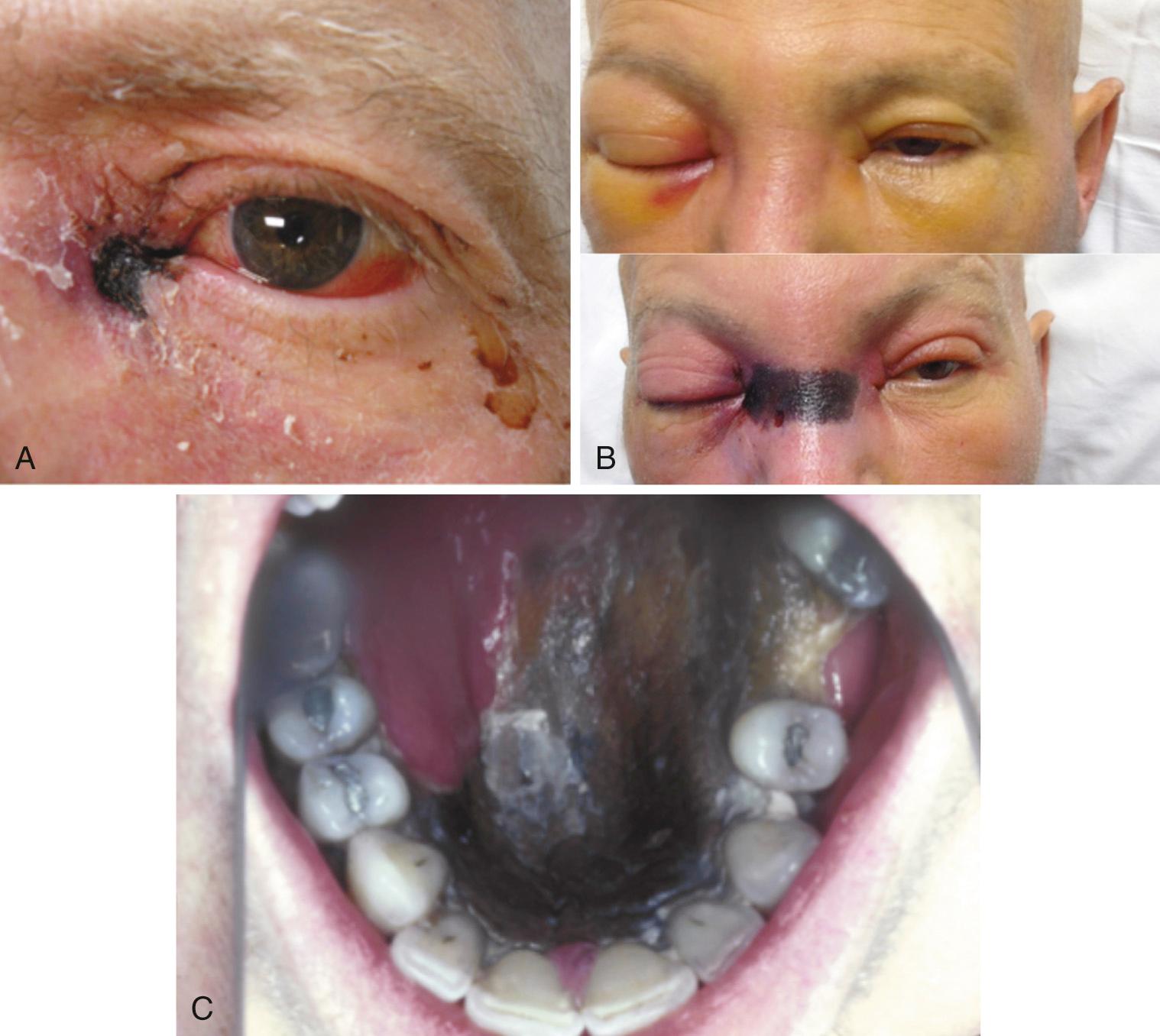
Initial symptoms of sinus invasion by mucormycosis are indistinguishable from other more common causes of sinusitis. Sinus pain, congestion, headache, mouth or facial pain, otologic symptoms, and hyposmia or anosmia are common. A concomitant nonproductive cough often reflects lung involvement. Involved tissues become red, then violaceous, and finally black with thrombosis and tissue necrosis. Necrotic eschars of the nasal cavity and turbinates, facial lesions around the nose, and exophytic or necrotic lesions of the hard palate extending from the maxillary sinus are signs of rapidly progressing infection. Careful endoscopic inspection of the nasal cavity and biopsy of suspicious lesions is helpful for early diagnosis. However, the absence of lesions or necrotic eschars does not rule out the possibility of rhinocerebral infection because necrotic nasal or palate lesions may be seen in only 50% of patients within 3 days of the onset of infection.
Extension of sinus disease is primarily into contiguous structures. Maxillary sinus infection extends into the hard palate, nasal cavity, and ethmoid sinus. Sphenoid disease invades the cavernous sinus, contiguous temporal lobe, and internal carotid artery in the siphon. Septic emboli from the carotid artery into the frontal and parietal lobes can occur. Ethmoid sinus disease may invade the face or frontal lobe but easily crosses the lamina papyracea into the orbit. The frontal sinus is an uncommon primary site. Invasion of the orbit is typically unilateral (see Fig. 258.4 ). Periorbital edema, ptosis, proptosis, chemosis, and preseptal and orbital edema are early signs of orbital extension. Pain and blurring or loss of vision often indicate invasion of the globe or optic nerve. Infraorbital facial numbness follows invasion of the infraorbital nerve within the orbit. Patients with extensive rhino-orbital or rhinocerebral disease may present with trigeminal and ocular motor nerve palsy after cavernous sinus invasion (cranial nerves III, IV, and VI, and the superior two branches of the fifth nerve). A bloody nasal discharge may be an early sign of nasal mucosal invasion. Intracranial complications include epidural and subdural abscesses, cavernous, and, less commonly, sagittal sinus thrombosis. Frank meningitis in patients with mucormycosis is rare.
Radiographic imaging is often suggestive of severe sinusitis but lacks the specificity to diagnose rhinocerebral mucormycosis. Patients with fungal or surgical disruption of the dura mater may present with superimposed bacterial meningitis, or bacterial sinusitis may complicate postoperative management. Computed tomography (CT) of the sinuses typically reveals mucosal thickening, air-fluid levels, and bony erosion ( Fig. 258.5 ). Highly immunosuppressed patients often present with pansinusitis that is highly suggestive of an aggressive fungal infection. Orbital thickening may also be detected on CT scans but can be detected earlier by magnetic resonance imaging (MRI). CT and MRI scans of the orbits may be unremarkable during the initial stages of the infection, highlighting the importance of serial radiographic imaging for monitoring disease progression. The frequency of radiographic imaging is patient dependent but may be required every 2 to 3 days in patients with suspected progression. Therefore rhinoscopy or nasal endoscopy is critical for confirming tissue ischemia and the extent of disease. Extraorbital muscle thickening is often the first sign on CT or MRI of orbital involvement and should prompt empirical antifungal therapy until surgical exploration or biopsy of the sinus and orbits can be performed, which should be done as soon as possible. Every effort should be made to establish an early definitive diagnosis of mucormycosis by biopsy and culture of necrotic lesions and rapid histologic assessment of frozen sections. Impression smears from the biopsy or surgical margin may also reveal hyphae consistent with mucormycosis.
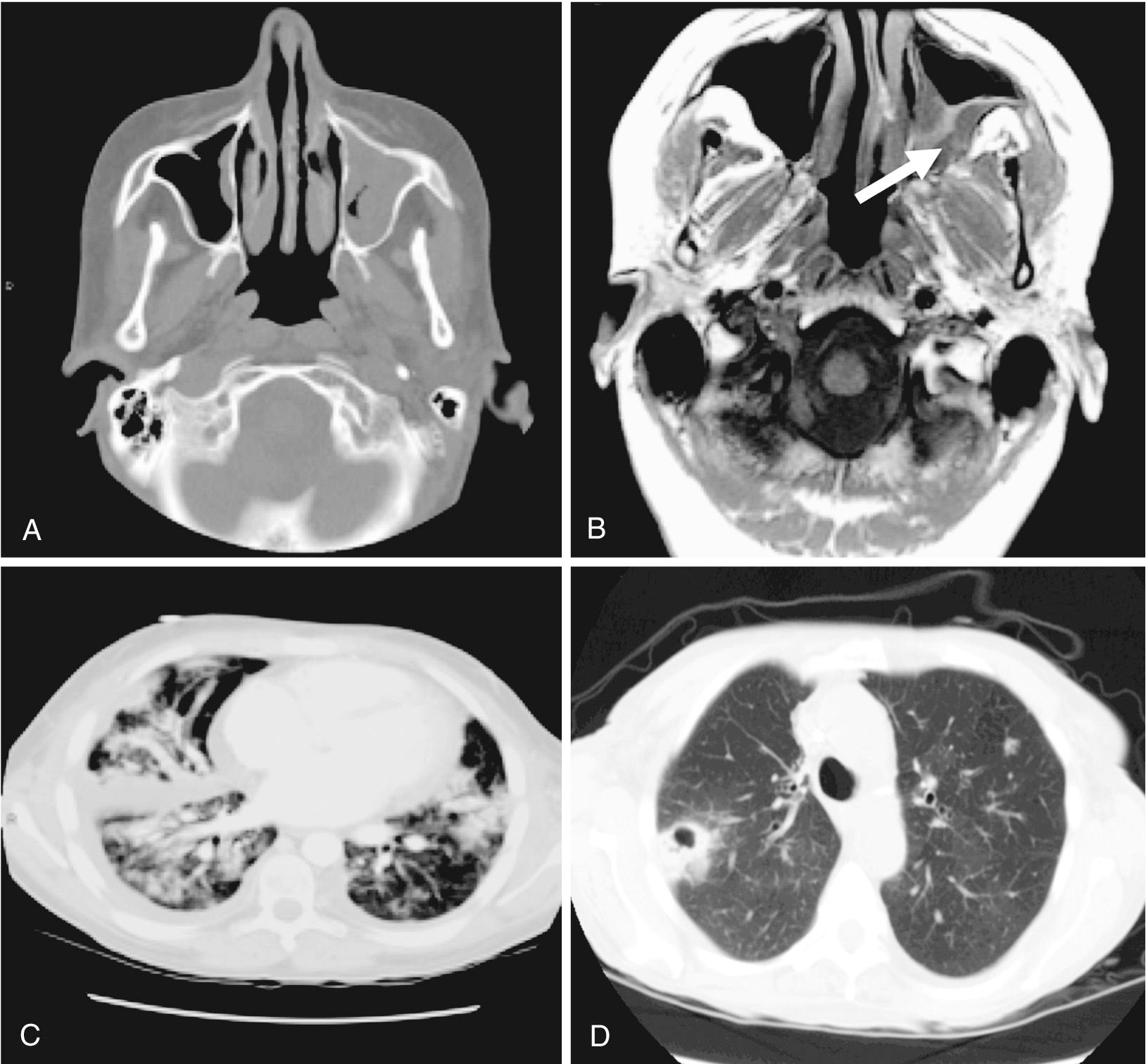
Pulmonary mucormycosis is most commonly encountered in patients with prolonged neutropenia, recipients of hematopoietic stem cell or solid-organ transplantation, and patients receiving deferoxamine therapy. The infection frequently occurs concomitantly with sinus infection. However, the clinical manifestations of the infection are indistinguishable from more common opportunistic molds, such as invasive pulmonary aspergillosis (IPA). Therefore timely diagnosis is a critical factor in the outcome on the infection because first-line antifungals typically used for aspergillosis, such as voriconazole, lack activity against Mucorales. A case series of 61 leukemia and transplant patients with evidence of fungal pneumonia found that 84% of patients who were eventually documented to have pulmonary mucormycosis were receiving ineffective antifungal therapy at the time of their diagnosis. Similarly, an analysis of 70 hematologic malignancy patients with pulmonary mucormycosis demonstrated that a delay in the administration of appropriate antifungal therapy (typically an amphotericin B formulation) of as few as 6 days was associated with a doubling of 4-week (35.1% vs. 66.6%; P = .006) and 12-week (48.6% vs. 82.9%; P = .029) crude mortality rates. Data to support imaging findings that might heighten the suspicion for pulmonary mucormycosis are reported in a retrospective analysis of neutropenic leukemia patients. In the first 5 days of clinical symptoms, fever or chest pain, a reverse halo sign (focal ground-glass attenuation surrounded by a ring of consolidation) was present in 15 of 16 patients with proven pulmonary mucormycosis. However, the reverse halo sign is not specific for mucormycosis but, rather, may be suggestive of invasive aspergillosis, mucormycosis, or organizing pneumonia.
Become a Clinical Tree membership for Full access and enjoy Unlimited articles
If you are a member. Log in here